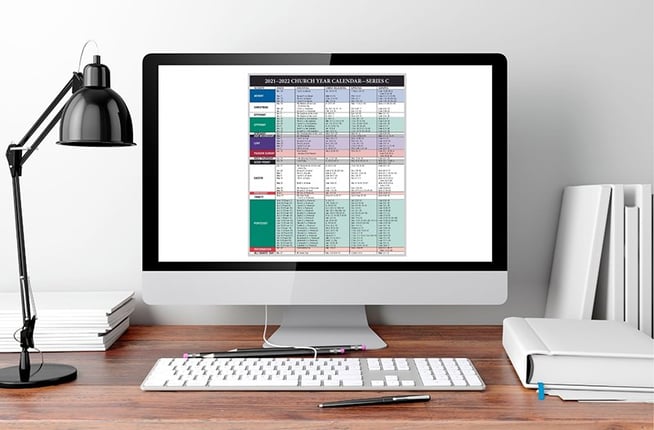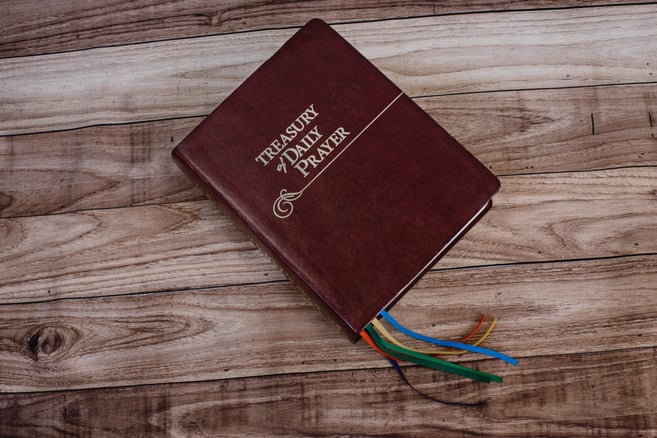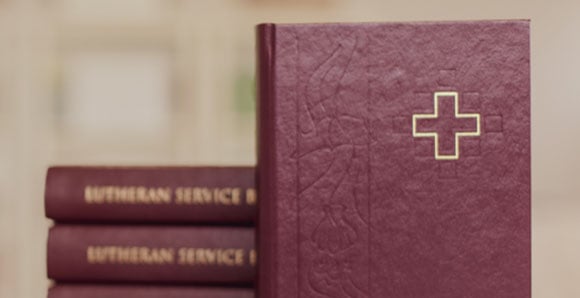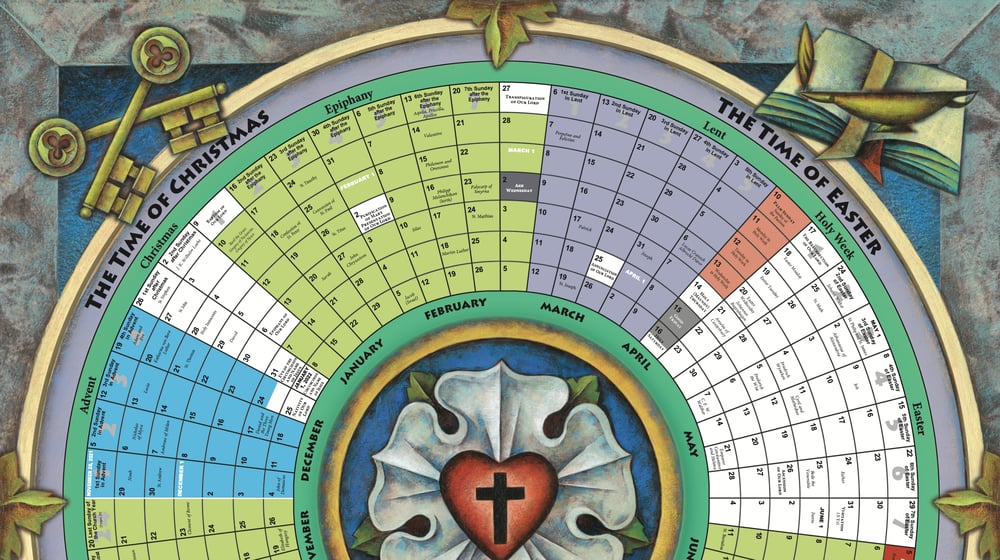The following is a brief guide to the traditional seasons of the Church and the liturgical calendar. This introduction is a perfect starting point for learning about the Divine Service throughout the year and an easy hub for reviewing what you’ve learned!
The Seasons of the Church Year
Isn’t a season just a season? Don’t worry, it is! The Christian Church gets spring showers and autumn leaves just like everyone else, but you won’t find summer or winter listed among the Christian Church’s seasons! In the language of the Church, seasons refer to different stages of the year when we focus on some specific aspect of the Christian life. Consider, for example, Christ’s resurrection. You likely already know that Easter is the day we celebrate Christ’s resurrection. Well, the events of Easter are so important to the Church that it doesn’t dedicate just one Sunday to thinking about it! Instead, the Christian Church dedicates an entire season to Easter, beginning with Easter Sunday and continuing for seven weeks until the celebration of another important Biblical event—the Day of Pentecost.
Some seasons of the Church Year are easy to remember—like the Easter or Christmas seasons—but others, like Advent, Lent, and “Ordinary” time, may be less familiar. Don’t worry! God’s Word and work for you is constant no matter the season. By just showing up to church each Sunday, you’ll get to see the gifts He offers. When you attend services, you’ll pick up on the celebrations of the seasons naturally. But if you are hoping to learn more, you have come to the right place.
The Christian calendar is retained in Christian Church bodies throughout the world for several reasons. First, a regular calendar is helpful to keep the remembrances before us. Just as God commanded the Jewish people to recall how He delivered them in the past (e.g., the Passover, Exodus 12:14; Leviticus 23:4–8), so, too, early Christians recalled the historic time-related events that were important to their faith, as Jesus had encouraged His disciples to do (Luke 22:19). Second, following their Jewish predecessors, Christians consider the regularity of the holidays as teaching moments, with the celebrations of the events of Christ’s life used to tell and retell the Good News. Finally, Christians recognize that this life is not an end in itself. Christ’s victory over death means that daily life focuses beyond the mundane to eternity. A calendar of Christian events unites present-day believers with those of the past as well as the future.
— Treasury of Daily Prayer, p. 8
Below, you’ll find brief overviews of every season of the Church Year to learn the how, the why, and the history of the liturgical calendar.
Where Do We Begin?
The best place to begin understanding the seasons is the person of Christ Himself. (Him, and colors, but we will get to that in a bit.) The Church’s seasons largely follow the “seasons” and major events of Christ’s life: His birth, ministry, death, resurrection, and ascension. You already know two: Christmas and Easter. Each season has another season before them that’s all about preparation. During Advent, the Church focuses on the coming of Christ. Advent ends with Christmas, Christ’s arrival through His birth as a baby. The season of Lent serves as the preparatory season for Easter, taking a more somber tone and reflecting on the suffering that Christ endured during His death on the cross. These seasons are the foundational celebrations of the Church Year.
If I Walk in a Church, How Will I Know the Season?
One of the best tools to immediately recognize the season is the color that is being used for each celebration. (Your pastor will likely mention the season at some point during the service as well.) Have you seen banners on the walls or colorful cloths on the altar in church before? What about the clothes your pastor wears? If your church follows the traditional celebrations of the seasons, these colors will all be full of meaning!
Each season has colors dedicated to it. The basic colors you’ll see the most are green, a symbol of growth; black, a symbol of sorrow; violet, a symbol of Christ’s royalty; white, a symbol of purity; and red, a symbol of power. More recently, some churches have begun occasionally using blue, for hope; gold, for grandeur; and scarlet, for sacrifice and martyrdom. Below, we’ll connect each of these colors with their respective seasons.
The Season of Advent
Dates: The Fourth Sunday before Christmas (December 25) through midday prayer on December 24
Colors: Violet or blue, rose
The Church Year starts with Advent, a series of four Sundays before Christmas. The name comes from the Latin word adventus, meaning “coming in to.” This name confesses the fact that in Advent, the Church eagerly awaits Christ’s past, present, and future coming—in the past His birth as a child, in the present as He comes to us in His Word and Sacraments, and in the future when He returns to judge the world. Advent highlights Christ’s arrival. Readings from the Old Testament prophecies of the Messiah and the ministry of John the Baptist remind us that Christ has been God’s promise to us since the beginning (see Genesis 3:15). Often, churches will add midweek evening services to help set the season apart and reflect on God’s promise of a Savior.
The typical colors for the season are either violet, which shows Christ is the royal Prince of Peace and Savior of the nations, or blue, which invokes the hope of the Messiah promised to Israel and the world. Many churches will also use an Advent wreath with three violet and one rose- (or pink-) colored candles encircling a single larger white candle. Each Sunday, one candle on the wreath is lit as a countdown to Christmas, when the white candle is finally lit as a sign of Christ’s incarnation.
This season contains the festival days of St. Andrew, the Apostle, (November 30) and St. Thomas, the Apostle (December 21).
The Season of Christmas
Dates: Evening Prayer on Christmas Eve (December 24) through midday prayer on January 5
Colors: Gold and white
On Christmas Day, the Church celebrates the birth of Jesus Christ by the Virgin Mary in Bethlehem. It’s a big deal! So much so that the traditional Christmas season isn’t just a day, it’s twelve! To start the season, some churches will hold a Christmas Eve service stemming from a tradition (sometimes still practiced) of a midnight service as the first and immediate celebration of Christ’s birth. Beginning with Christmas Day, the season continues for twelve days and culminates with a new season, the Epiphany of Our Lord.
The colors for the Christmas season are gold for Christmas Day, one of only two golden days in the calendar, and white for the remainder of the season.
Several other important festival days fall between Christmas and Epiphany, including the festival days of St. Stephen the Martyr (December 26), St. John the Apostle and Evangelist ( December 27), and the Festival of the Holy Innocents and Martyrs (December 28). The season also includes two feast days besides Christmas—both the eve (December 31) and day (January 1) of Jesus’ circumcision and naming, where at eight days old, Christ was already fulfilling the Law for us.
The Season of Epiphany
Dates: Evening Prayer on January 5 through the Tuesday before Ash Wednesday
Colors: White and green
Epiphany begins with the Feast of the Epiphany of Our Lord, which celebrates the visitation of the Magi to the infant Christ. The word Epiphany means “manifestation” or “revealing.” It comes from the Greek word epiphaneia. Epiphany also marks the first time the Messiah was shared with those outside of Israel, the Gentiles.
When the Gentile Magi come to worship Jesus, they show that everyone now has access to God. Now all people, Jew and Gentile, can come to God’s temple and worship, because Jesus is the new temple: God in the flesh.
—Treasury of Daily Prayer, p. 9
The First Sunday after Epiphany is the Feast of the Baptism of Our Lord, which celebrates Christ taking on the sins of Israel and all mankind and modeling repentance for our wayward world. The final Sunday during Epiphany celebrates Christ’s Transfiguration. It commemorates the day when Christ shared a glimpse of His divinity to the disciples Peter, James, and John up on a mountain. Appearing between Moses, a symbol of the Law, and Elijah, a symbol of the prophets, Christ showed Himself to be the fulfillment of both.
The colors for Epiphany are white for the feast of Epiphany itself and green for the remaining Sundays.
Festivals in this season celebrate the Confession of St. Peter (January 18), St. Timothy (January 24), the Conversion of St. Paul (January 25), St. Titus (January 26), and others depending on when Ash Wednesday falls.
The Season of Lent
Dates: Ash Wednesday until midday prayer on Holy Saturday
Colors: Black, violet, scarlet, and white
Lent is a somber forty-day period (not including Sundays) before Easter where the Church reflects on human sinfulness and practices repentance. The name comes from the old English word lencten, which referred to the early months of spring, the same time Lent began. But the earliest reference to the practice comes from the council of Nicaea in AD 325. (see Treasury of Daily Prayer, p. 10). It begins with Ash Wednesday, when God’s people receive a cross of ashes on their foreheads along with a reminder: “For you are dust, and to dust you shall return” (Genesis 3:19). “The placing of ashes on the forehead is a sign of penitence and a reminder of human mortality” (Treasury of Daily Prayer, p. 10). Following Ash Wednesday, Lenten Sundays are numbered, and their readings include Old Testament passages on repentance and portions of Christ’s ministry. Most churches also continue to practice Wednesday evening services throughout Lent. Palm Sunday comes one week before Easter, initiating Holy Week and commemorating Christ’s triumphal entry into Jerusalem. During Holy Week, the events of Jesus’ final days come in quick succession, with Holy (Maundy) Thursday commemorating the Last Supper, Good Friday remembering His betrayal and crucifixion, and Holy Saturday anticipating Christ’s resurrection.
The main color of Lent is violet, but each of the three instances of liturgical black occur during Lent in the cases of Ash Wednesday, Good Friday, and Holy Saturday. Palm Sunday uses red as a symbol of Christ’s suffering to come, and Maundy Thursday adopts white to reflect the purity of the Lord’s Supper.
Each year, several festivals fall within the Lenten season. But because the start and end dates are variable, the only festival that always falls within Lent is the day of St. Joseph, Guardian of Jesus (March 19). Depending on the year, St. Mattias the Apostle’s day (February 24) may come during Lent, as could the feast of The Annunciation of Our Lord (March 25), which celebrates the angel Gabriel’s visit to Mary and the conception of Jesus Christ.
The Season of Easter
Dates: Easter Sunday until Pentecost
Colors: Gold and white
Easter Season begins with . . . You guessed it: Easter Sunday. But when is that? Well, the date of Easter Sunday each year is based on the Jewish dating of the Passover, which relies on a lunar month calendar. Following this, Christians celebrate Easter on the first Sunday following the first full moon after the first day of spring. It is a lot of firsts, but Christ’s resurrection was also a first!
Traditionally, an Easter Vigil service would be held the day before Easter on the evening of Holy Saturday, timed so that its concluding phrase “Christ is Risen, Alleluia!” will usher in Easter and its celebrations.
The Vigil includes a service of light, in which fire symbolizes Jesus as the light of the world. The service is designed to take the Christian from the solemnity of Good Friday to the predawn joy of Easter.
—Treasury of Daily Prayer, p. 11
Forty days after Easter Sunday, the Church celebrates the Ascension of Our Lord. On the final Sunday of the season, the Church celebrates Pentecost.
Easter season, celebrated as Pentecost, was adopted by early Christians to commemorate the first great harvest of believers for Christ (Acts 2:1–41). Thus Pentecost is the birthday of the Christian Church as the Holy Spirit came upon the disciples and they gave their compelling witness about the resurrected Lord.
—Treasury of Daily Prayer, p. 11
During Easter, the Church especially gives thanks to God for Christ’s ultimate sacrifice on the cross and the glorious resurrection promised to believers through Him.
The fifty days between Easter and Pentecost, known as the Great Fifty Days, was the first liturgical season observed in the first three centuries of the Church. This fifty-day celebration is a week of weeks, renewed in the last decades by emphasizing the Sundays as being “of Easter.”
—Treasury of Daily Prayer, p. 11
Easter Sunday uses the color gold, celebrating the resurrection as a crowning glory of Christ’s work. Pentecost uses red, recalling the flames of the Holy Spirit and foreshadowing the blood shed by the martyrs. The rest of the season uses white, representing holiness, glory, joy, and purity.
The festivals of St. Mark the Evangelist (April 25) and the Apostles St. Philip and St. James (May 1) always occur during the Easter Season, and others such as St. Barnabas the Apostle (June 11) may also fall within the season.
The Season after Pentecost
Dates: The day after Pentecost until the Saturday before the First Sunday of Advent
Colors: Red, white, and green
The first Sunday after Pentecost is Trinity Sunday, when the Church celebrates the holy mystery of the Trinity and recites the Athanasian Creed. After Trinity Sunday, the next several months consist of counted “Sundays after Pentecost,” sometimes known as Ordinary time. This period runs until the end of the Church Year, setting the stage in late November for the beginning of Advent.
On the Last Sunday after Pentecost, the Church gives voice to the joyful hope of the second coming of Jesus for the resurrection of the dead and the last judgment. The end-times focus on the Last Sunday of the Church Year bears themes of hope and preparation that are similar to those of Advent, which soon follows.
—Treasury of Daily Prayer, p. 12
Several lesser-known but equally important Sundays also fall into this season. Lutherans and many Protestant denominations celebrate Reformation Day on October 31, commemorating the steadfast confessions of Martin Luther, Martin Chemnitz, Philip Melancthon, and other faithful reformers. On the next day, November 1, the Church observes All Saints’ Day, a celebration of those who have died in the faith and are now with Christ.
Reformation Day uses the color red for similar reasons to Pentecost, remembering the strife of the Church during the time of the Reformation. Green symbolizes a time of growth and new life on the Sundays after Pentecost. Finally, Holy Trinity Sunday and All Saints’ Day use white as a symbol of God’s purity and forgiveness of sins.
One of the longest continuous seasons in the Church calendar, the season after Pentecost includes many additional festivals, ranging from the day of St. Mary, Mother of Our Lord (August 15) to the Apostles St. Simon and St. Jude (October 28). The Feast of the Visitation (May 31 or July 2 depending on the lectionary your church uses) also falls within the post-Pentecostal season, celebrating the meeting of Mary and her older cousin Elizabeth and the infant John the Baptist leaping in Elizabeth’s womb as he recognized the incarnate Christ in Mary’s womb.
How Do I Keep Track?
Everything above can be a lot to take in! This has been a breakneck tour of the liturgical calendar, but fortunately, there are some great tools for keeping track of everything yourself.
Free Calendar Download
For quick reference, you can download a free Church Year calendar. This handy spread includes the seasons, colors, dates, festivals, and even suggested readings for the entire year. This printer-friendly calendar can be kept around your home, or you can make multiple copies to distribute at your church.

A Prayer Book and Calendar
If you are looking for deeper engagement with the Church Year and its seasons in your personal and devotional life, The Treasury of Daily Prayer (already quoted throughout this very post!) is the book for you. Not only does its opening section offer a more in-depth overview of each season, including full calendars of the seasons, feasts, festivals, and commemorations, it also provides 365 days of material directly aligned with the liturgical calendar. Each daily spread includes an uplifting psalm, Old and New Testament readings, a brief devotional writing, a prayer, a selection or suggested reading from Concordia: The Lutheran Confessions, and a stanza of a hymn from Lutheran Service Book. With Treasury of Daily Prayer, you’ll begin to live out every day in the spirit of its season.

A Hymnal
A personal copy of Lutheran Service Book might be just the thing for you! The bulk of LSB consists of a beautiful collection of hymns, and each is sorted into its proper season or topic. LSB also includes a short introduction and reference to the liturgical calendar to help you keep track. As a devotional item, LSB is full of prayers, short personal services, and uplifting hymns for every season of the Church Year. Another bonus of having your own copy is that you’ll always be able to follow along with the Divine Service in most Lutheran churches that follow the traditional liturgy!

Excerpt adapted from Treasury of Daily Prayer, pp. 8–12. Copyright © 2008. Published by Concordia Publishing House. All rights reserved.
Scripture: ESV®.















